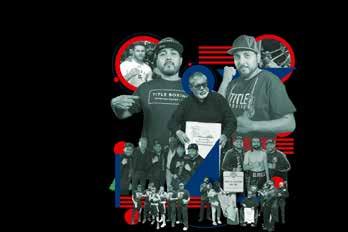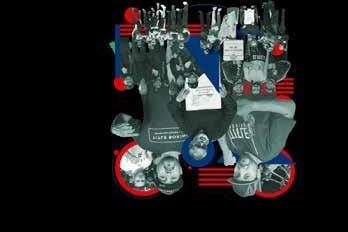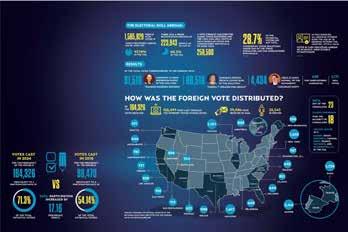

The race for number 2 Vance vs Waltz
UNDERSTANDING WHAT IS AT STAKE AND THE CHARACTERS IN THE UPCOMING ELECTION AS KEY PIECES TO PUT TOGETHER THE PUZZLE.
• Full Name: James David Vance (originally James Donald Bowman)
• Born: August 2, 1984, in Middletown, Ohio
• Early Life: Grew up in a working-class family in Middletown. Raised primarily by his maternal grandparents due to his mother’s struggles with addiction.

THE RACE
Education:
• High School: Middletown High School (2003)
• Bachelor’s Degree: Ohio State University (Political Science and Philosophy)
• Law Degree: Yale Law School (2013)
UNTIL RECENTLY,
M• Military Service: Served in the U.S. Marine Corps, including deployment in Iraq.
Career:
• Author of Hillbilly Elegy (2016), which explores the struggles of the white workingclass and garnered national attention during the 2016 election.
Worked as a lawyer and venture capitalist before entering politics.
Political Career:
• Elected as a U.S. Senator from Ohio in 2022 and became Donald Trump’s running mate for the 2024 presidential election.


THE CHOICE OF A VICE-PRESIDENTIAL CANDIDATE WAS A BIT OF A SIDESHOW MADE ALWAYS WITH THE INTENTION OF BALANCING A TICKET, EITHER GEOGRAPHICALLY OR IN TERMS OF DIVERSITY, BUT NEVER BEFORE HAD IT BECOME SUCH A CRUCIAL QUESTION.

MONDAY / 09 / 09 / 2024 HERALDOUSA.COM/
But the American dream that always counted most was not starting a business or becoming a senator or even being here with you fine people, though it’s pretty awesome. My most important American dream was becoming a good husband and a good dad. 02-03
IDENTIDAD LOGO RUTA IDENTIDAD2024LOGO


aybe it was about Joe tal health, forced to sure from his own party, Donald Trump, and because now, it is Donald is seen as someone potential in his vice when we look at both we must imagine the Tim Walz, eventually of the White House. This coming presidential very much about the president. Therefore, Donald Trump be his running mate safe and logical choice, standards. A young man who raised himself poverty” to become a tech millionaire, Vance picture of someone Rockwell painting. once vilified Donald tween Richard Nixon that was back in 2016, process of becoming his autobiographical not yet thinking of a in MAGA Politics. By criticizing Mike Pence electoral boat recount


hillbilly upbringing, and sympathy in that that Trump apparently afford to offend. To plicated, some comments

TIM WALZ:
RACE
Numberfor 2
was considering a career in politics and now at odds with Maga scripture, and yet others that he made once he was looking to position himself as the new generation of the American right wing are coming back to haunt him, and not only with “childless cat ladies”” but with female voters in general.
Add to that the fact that he is not the most gifted of orators And that his own family is perhaps two diverse and 21st century for some of the most traditional and conservative of Maga voters. What at first made vans look appealing and interesting to middle of the road Americans who have a more open view of immigration and of the role of women in the workplace has been more than downplayed by Vances unfortunate comments about women in general and even about his own family, where after being greeted by icy silence at the GOP convention when he played up his wife’s ethnicity and lawyer credentials, he has gone back in spades by now, referring to their children as “her children”.
was the long discussion Biden’s physical and menhealth, or the fact that he was decline under men’s presparty, from his opponent, and from the media. Maybe Donald Trump himself who someone who needs to think of a vice president. Be it as it may, both vice presidential choices, the concept of JD Vance or eventually sitting in the Oval Office House. presidential election is also the two men running for vice Therefore, let’s have a look at them: Trump picked JD Vance to mate it seemed like a pretty choice, even by Trumpian young up-and-coming white himself up from “hillbilly become a best selling author and Vance cut this wholesome someone almost out of a Norman Never mind that he had Donald Trump and painted him might be somewhere in beNixon and, yes, Adolf Hitler. But 2016, when Vance Was in the becoming famous for his book for autobiographical book, hillbilly elegy, and career in politics, let alone
By 2020, JD was already Pence for his handling of the recount and for his role during and not long after that, he was endorsement as he ran for the state of Ohio. He’s 180° regarding Trump maybe be seen but neither one of the two hold grudges, in Trump’s in Vance’s. seemingly safe bet has turned more controversial, and defisuccessful than what some pundits
Some cracks have begun autobiographical narrative, flattering comments about state, as well as about his upbringing, are costing him support that sector of the electorate apparently has in hand, but cannot make matters more comcomments he made before he
To be fair to Vance one must remember that he was chosen as Trump’s running mate back when the race was against a visibly weekend Joe Biden and the BP choice was more about softening up Trump image a bit image a bit towards women, a crucial segment that has been largely alienated, not only by Trump’s antiques, but also buy increasing limits in women’s right to choose, and in what they perceived to be a right limiting or reversing agenda in the GOP and particularly in Maga.
Does that mean that Vance is now more of a liability than an asset? I would not make that assertion yet, but given the way, the race is shaping up, it is fair to say that some in the Trump camp may be wondering today whether they should have considered a running mate for a much more competitive election than what they chose.
It’s a little bit late now for the what if so, the Republicans will have to make to with a ticket that was made for another race and hope (or pray) that their hard-core voters will come out in droves and not be put off by what now appears to have been and unorthodox combination for the White House.
In the case of the Democrats, Tim Walters’s choice was less of an issue given the fact that their ticket was dramatically re-energized when President Biden declined to continue running and vice president Kamala Harris came in with all guns blasting. Given Harrises intensity, It was more about finding a running mate that would be geographically and politically balanced, i.e. less ideological and more down to earth, or folksy, And at the same time that could keep the energy levels on high and be A strong debater that could attempt to face down JD Vances White southern appeal.
Waltz It’s a bit of a political rarity, a Democrat governor in a traditionally r red state Who has pushed through progressive legislation and navigated successfully, his former perfect Voting record for the NRA into a more nuanced stance on guns: A hunter who believes in gun control, albeit rather moderate control.
His bio reads like one of those all American clean, cut stories. A sports coach marine, a family man with little if any scandals or controversies to talk him. The fact that there is not too much to say about him, is precisely the most telling aspect of Tim Waltz: A forceful speaker, a very traditional look, and just the right age and balance in case people are thinking of the future.
In a nutshell, everything that could’ve been said about the VPs was turned on its head once Joe Biden stepped aside and Kamala Harris became the candidate.
All bets are Is there off now and we have less than two months to see what all four contenders are made of. Enjoy the show.
• Full Name: Timothy James Walz
• Born: April 6, 1964, in West Point, Nebraska
• Early Life: Grew up in rural Nebraska and attended high school in Butte, Nebraska.
Education:
• Bachelor’s Degree: Chadron State College (History)
• Master’s Degree: St. Mary’s University of Minnesota (Educational Leadership)
• Military Service: Served in the Army National Guard for 24 years, retiring as a Command Sergeant Major.
Career:
• Before entering politics, Walz was a high school teacher and coach in Minnesota.
• He was first elected to the U.S. House of Representatives in 2006, representing Minnesota’s 1st Congressional District.
Political Career:
• Served in the U.S. House for six terms.
• Elected as Governor of Minnesota in 2018 and re-elected in 2022. As governor, he has focused on healthcare reform, education, and addressing the COVID-19 pandemic.
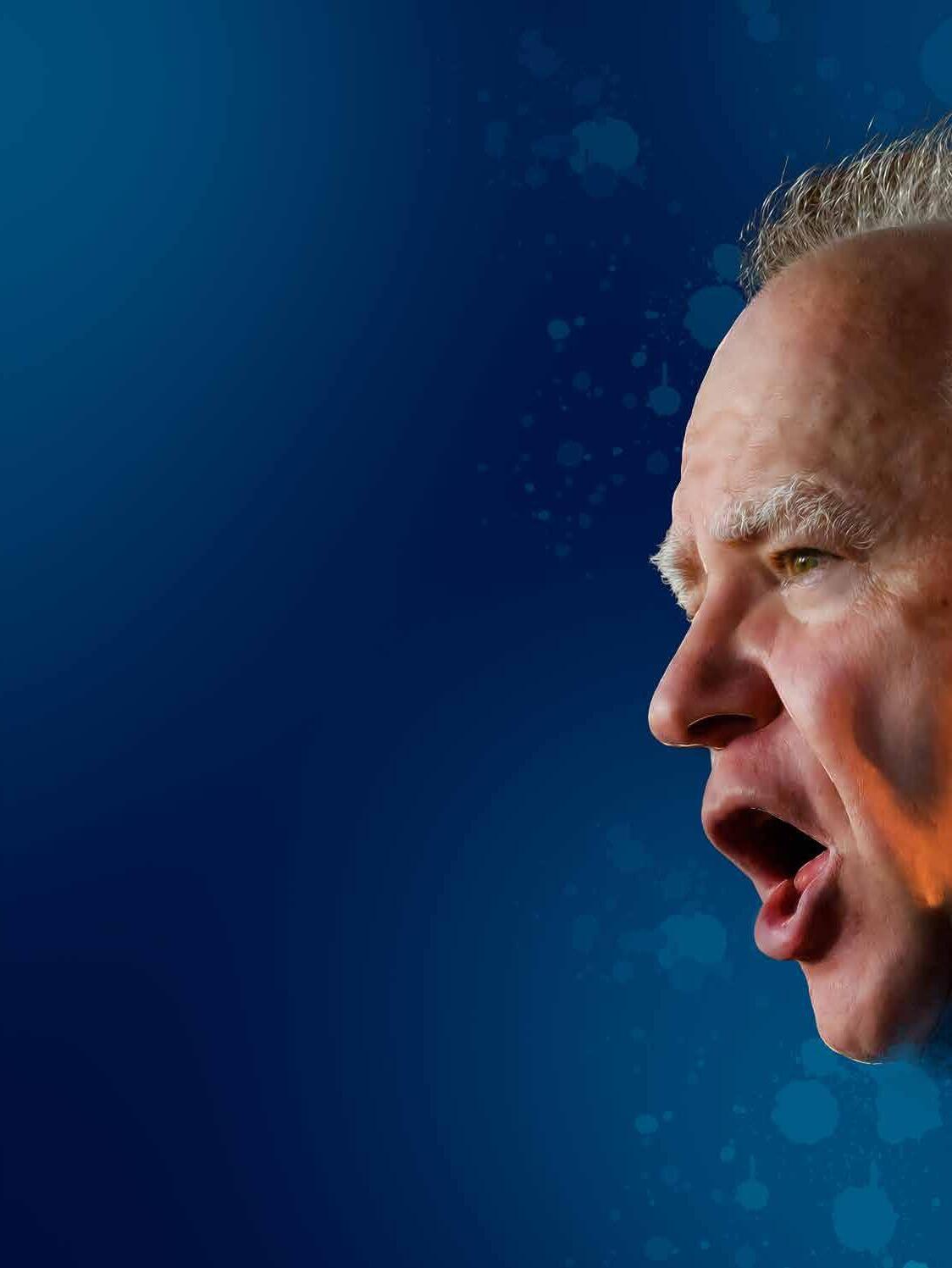
We’ll build a country where workers come first, health care and housing are human rights, and the government stays the hell out of your bedroom.
TIM WALZ’S Democratic Convention Speech
U.S. PRESIDENTIAL VISITS TO MEXICO
visits Ronald Reagan made to Mexico. 6 times U.S. Presidents have made official visits to Mexico. 35
VISITS TO MEXICO

REDACCIÓN
He met with President Porfirio Díaz in Ciudad Juárez.
"I welcomed you as a republican, and you receive me as an emperor," Taft told Díaz.
The president visited his peer, Manuel Ávila Camacho, in Monterrey.
He said that in the future, each President of both countries should feel free to visit the other.
He made a presidential visit to Mexico City.
Truman granted Mexico a $150 million loan.
He met with Miguel Alemán, who sought to open lines of credit for the industry.
He met with Adolfo Ruiz Cortines to inaugurate the Falcón Dam in Tamaulipas. He made two more visits.
The president visited his counterpart, Adolfo López Mateos, in Mexico City.
U.S. Presidents have visited Mexico. 15 times George W. Bush visited Mexico. 6 times Barack Obama visited Mexican soil. 5
They discussed the "Alliance for Progress", in which the U.S. would assist Latin America.
He visited Mexico City, Coahuila, and Chihuahua.
PHOTOART: ALEJANDRO OYERVIDES THE BILATERAL RELATIONSHIP HAS BEEN CLOSE BECAUSE MEXICO AND THE UNITED STATES SHARE A BORDER MARKED BY VARIOUS CONFLICTS, LEADING TO CONSTANT COMMUNICATION.
He held an informal meeting with Gustavo Díaz Ordaz.
HARRY S. TRUMAN (1947): 3
DWIGHT EISENHOWER (1953, THREE VISITS): 4
JOHN F. KENNEDY (1962): 5
FRANKLIN D. ROOSEVELT (1943): 2
WILLIAM HOWARD TAFT (1909): 1
LYNDON B. JOHNSON (1966-1967, THREE VISITS): 6
He inspected the progress of the Amistad Dam and handed over El Chamizal.
He visited Coahuila and Jalisco.
He inaugurated the Amistad Dam.
RICHARD NIXON (TWO VISITS, 1969-1970): 7
He met with his counterpart, Gustavo Díaz Ordaz.
U.S. LEADERS HAVE CAUSED A STIR ON MEXICAN SOIL
201
YEARS of diplomatic relations between Mexico and the United States.
#U.S.-MEXICO:
A LEGACY OF HISTORIC
A RESIGNATION:
*President Richard Nixon resigned in 1974 following the Watergate scandal.

GERALD FORD (1974): 8
JOE BIDEN (2023): 15


He traveled to Sonora to meet with Luis Echeverría. He supported the Charter of Economic Rights and Duties of States.
JAMES CARTER (1979): 9
RONALD REAGAN (1981-1988, SIX VISITS): 10
He initiated negotiations to purchase natural gas with his peer José López Portillo.
He met with López Portillo to discuss economic cooperation among Latin American countries.

GEORGE H. W. BUSH (1990): 11
BILL CLINTON (1997-1999, TWO VISITS): 12
GEORGE W. BUSH, (2001-2006, SIX VISITS): 13
BARACK OBAMA (2009- 2014, FIVE VISITS): 14
He was received by Carlos Salinas de Gortari in Agualeguas, Nuevo León, to discuss NAFTA.
Salinas recounted that Bush wanted to "trade" a migration plan for oil.
He met with Ernesto Zedillo in May 1997 in Mexico City.
They agreed to cooperate on anti-drug efforts, environmental issues, trade, and border security.
He was known as an ideal ally for Vicente Fox.
He visited Guanajuato, Los Cabos, Monterrey (twice), Cancún, and Mérida.
The first time he visited Mexico was in April 2009. Felipe Calderón hosted a dinner for him at the Museum of Anthropology and History.
Other visits: North American Leaders' Summit and the G-20 in June 2012, in Los Cabos.
He met his counterpart, Andrés Manuel López Obrador, in Mexico City.
He participated in the North American Leaders' Summit and addressed the migration crisis on a bilateral level.
HISTORIC TIES



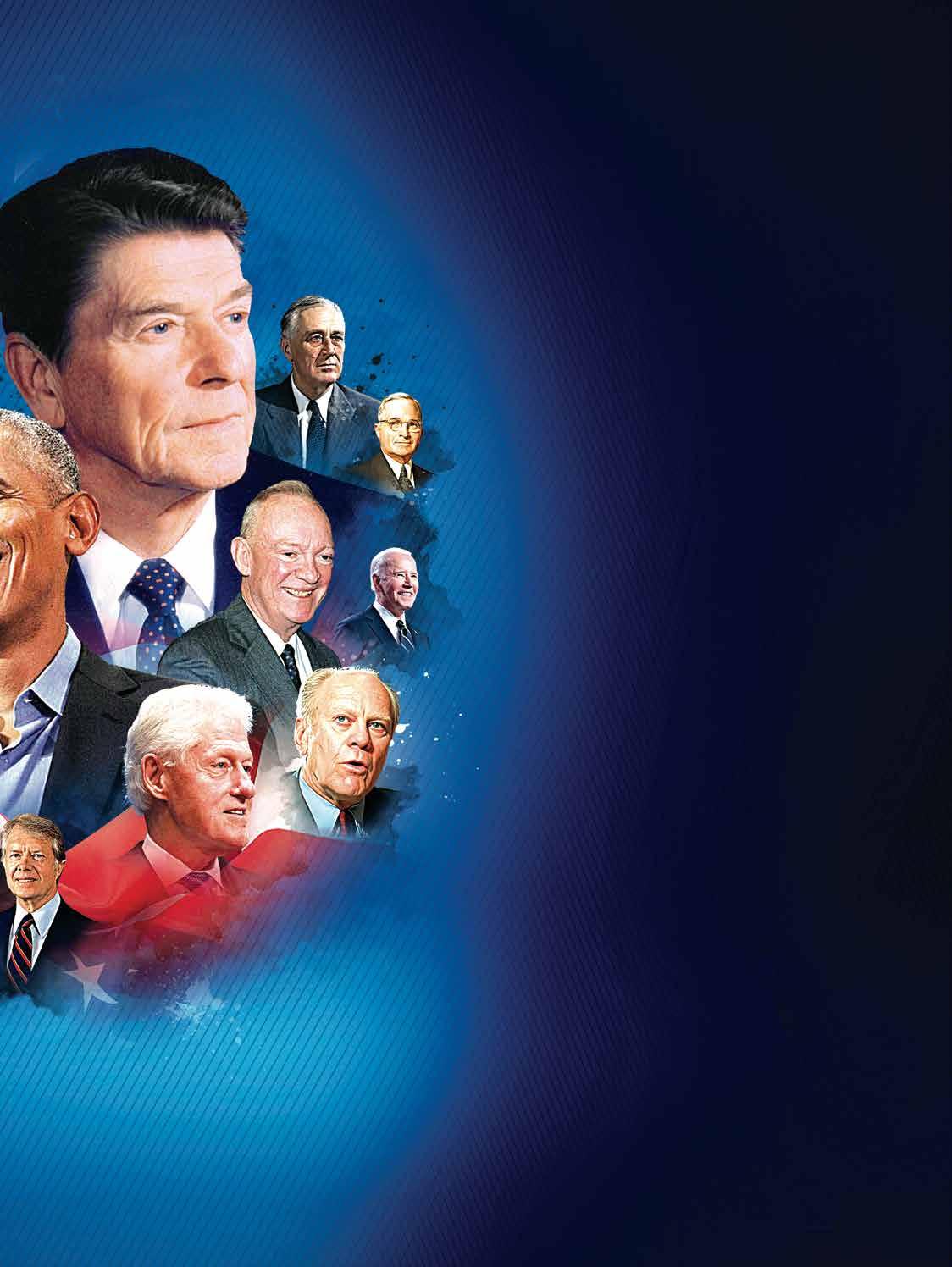
THE U.S. Constitution came into effect. PRESIDENTS have governed the United States.
LEADERS WHO DIED IN OFFICE




WILLIAM HENRY HARRISON, IN 1841.
ZACHARY TAYLOR, IN 1850.
WARREN G. HARDING, IN 1923.
FRANKLIN D. ROOSEVELT, IN 1945.
LEADERS ASSASSINATED IN OFFICE

ABRAHAM LINCOLN, IN 1865.


DECEMBER 2022 marked the bicentennial of bilateral relations. 1789 46

JAMES A. GARFIELD, IN 1881.
WILLIAM MCKINLEY, IN 1901.
JOHN F. KENNEDY, IN 1963. 12
370 comprehensive hospitals, surgical units, short-stay clinics, wellness areas, spas, laboratories, recovery and retirement homes, hotels, transportation, gastronomy, commerce, and businesses.
The Cali-Baja region is composed of the metropolitan area of San Diego and the Imperial Valley in California on the U.S. side, and Ensenada, Mexicali, Playas de Rosarito, San Quintin, Tecate, San Felipe, and Tijuana on the Mexican side in the state of Baja California.

Tijuana accounts for 57% of health tourism, with more than 8,000 healthcare providers.
$1.7 billion economic impact.
2.8 million tourists for health reasons.
$1.2 billion economic impact.
1.9 million tourists for health reasons.
million visitors.
from Canada, Europe, Australia, Japan, England, and Spain. 70% are U.S. patients. 30-55% are national tourists.
CALIBAJA
Crossing from Tijuana to San Diego, the most crossed border in the world and where the most trade takes place. The border city of Tijuana is known for various aspects; for locals, it is where the Homeland begins. The interesting thing about this border city is that it has become a fundamental part of a binational and cross-border region called Cali-Baja. It is the largest integrated economic zone along the Mexico-US border.
BY ALEJANDRA ICELA MARTÍNEZ RODRÍGUEZ
PHOTO: COURTESY OF THE ARTIST

San Diego is the Maritime Technology Center, generating 46,000 jobs and more than $14 billion in revenue.
San Diego and Ensenada are two maritime ports connecting San Diego, Baja California, and the Pacific.
Governor of California: Gavin Newsom (D) Mayor of San Diego
Governor of Baja California: Marina del Pilar Ávila Olmeda (Morena) Tijuana Mayor-elect (starting October 1, 2024): Ismael Bourgueño
INTERVIEW WITH AMBASSADOR ALICIA G. KERBER-PALMA, CALIBAJA: OPPORTUNITIES AND CHALLENGES ON THE BORDER
Consul General of Mexico in San Diego
The border cannot be viewed in isolation; its economic, social, and cultural characteristics define a binational region, particularly in the San Diego and Imperial Counties in the U.S. and the Mexican state of Baja California. Over time, this area has become known as “Calibaja”, a 227-kilometer zone distinguished by its unique and fascinating character.
BY PATRICIA TEPOZTECO ROMERO
PHOTO: COURTESY OF THE ARTIST
In March, Mexico led
Its dynamism is evident. The exchange of goods between both countries represents a staggering combined Gross Domestic Product of $266 billion, a testament to the region’s economic prowess. Additionally, nearly 7,000 cross-border students attend schools in San Diego, while 41,800 American students are enrolled in Baja California’s educational system.
San Diego and Imperial are located within the jurisdiction of the Consulate General of Mexico in San Diego, which has been headed since February 2024 by Ambassador Alicia G. Kerber-Palma, a salient member of the Mexican Foreign Service.
She is dedicated to maintaining close diplomatic relations with Mexicans in the United States and advocating for women’s rights. In 2016, she developed and implemented the Comprehensive Attention and Liaison Policy for Women (VAIM) at the Consulate of Mexico in Kansas City.
1 million trucks cross the Otay Mesa commercial port annually, making it the second most important port in the U.S.
7.1 million people constitute the total population of this border area across both countries.
Mexico invested $353 million to construct the Otay II checkpoint to facilitate trade and personnel crossings.
According to IOA, nearshoring in CaliBaja can benefit medical devices, semiconductors, aerospace, and vehicle manufacturing sectors.
Latinos comprise 36.5% of San Diego and Imperial Counties population, with 87% being of Mexican origin.
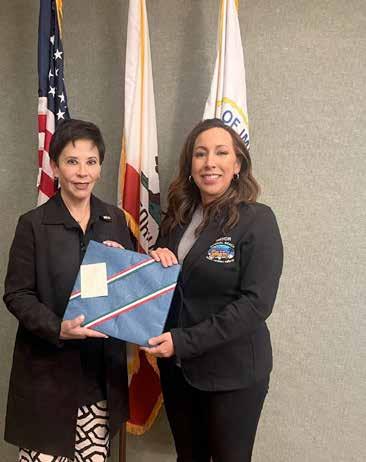
● WITH THE MAYOR OF IMPERIAL BEACH, PALOMA AGUIRRE the Consul General of Mexico in San Diego, Alicia Kerber Palma, has maintained constant dialogue to address environmental issues and promote cooperation between both countries to reduce wastewater pollution from Tijuana, Baja California.

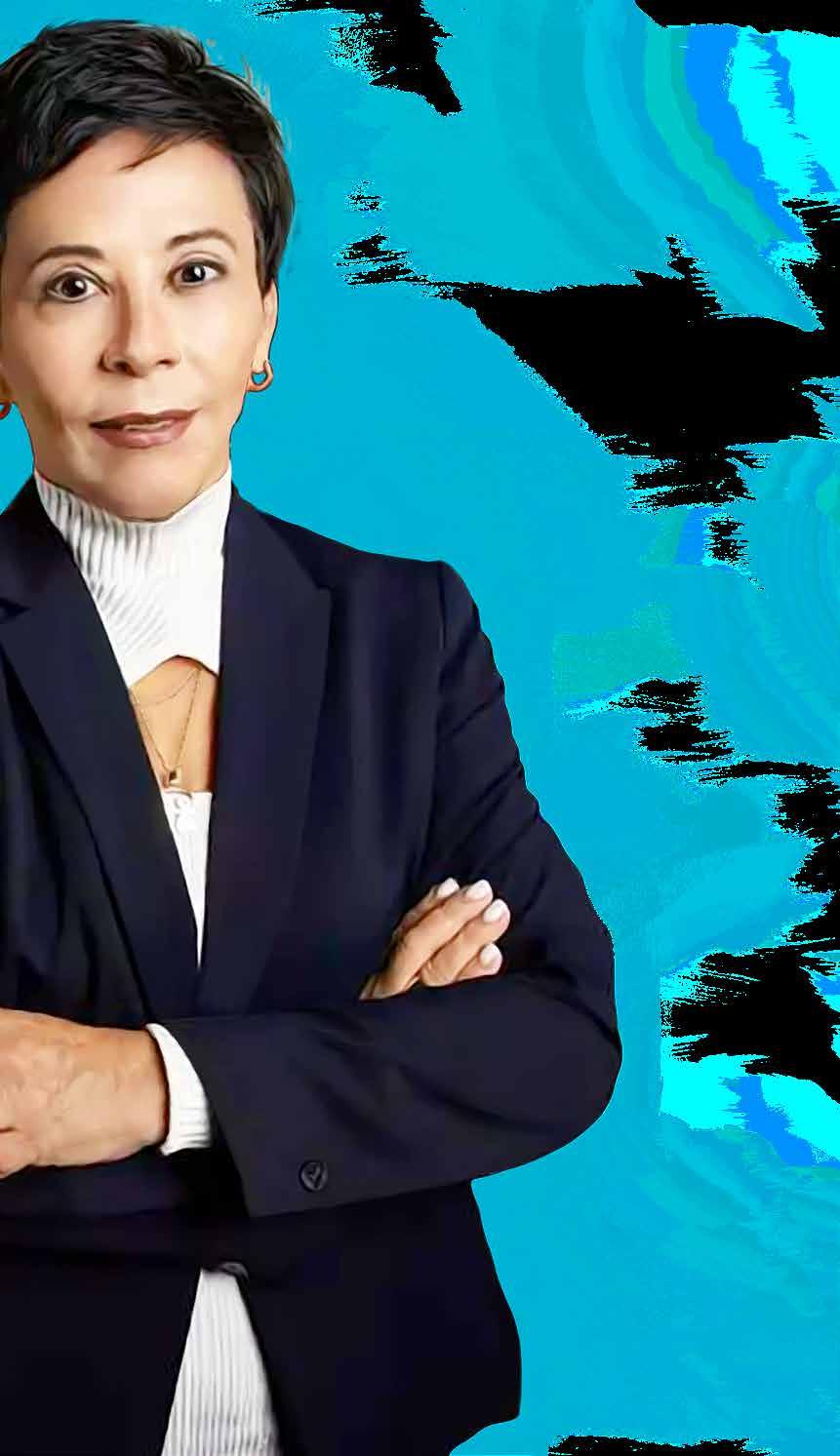

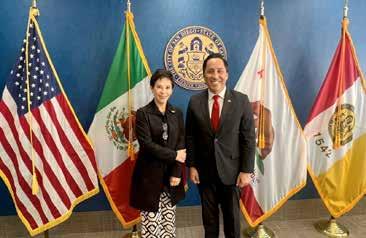

This policy aims to provide specialized and cross-cutting attention to the development and empowerment of migrant women. Currently, VAIM is implemented in all 53 Mexican consulates in the United States. Heraldo USA talked with her about the region’s challenges, opportunities, consular services, migration, nearshoring, and the relationship with the next U.S. government.
HUSA: What are the challenges of addressing this region?
AKP: The border dynamics present unique challenges. The area experiences constant cross-border movement, with nearly 16 million vehicles passing through the San Ysidro border each year and approximately 1 million people crossing daily.
This characteristic drives us to generate specific projects, programs, and services according to the region in diverse areas, such as culture, which is very sui generis.
HUSA: How does migration impact the region?
AKP: Migrants from Mexico living in San Diego contribute to prosperity by creating jobs, supporting businesses, paying taxes, and contributing to social security.
It is also essential to recognize that migrant women play a crucial role, representing 51 percent of the migrant population, which necessitates targeted policies. We are fully dedicated to addressing these needs.
HUSA: What are the main advances in consular care?
AKP: Undoubtedly, the feminist foreign policy and people-centered diplomacy driven by President López Obrador and Foreign Minister Alicia Bárcena.
Since 2019, Mexico adopted a feminist foreign policy, meaning all our services and programs will have a gender perspective. The goal is to reduce and eliminate gender gaps, inequalities, and violence to create safe spaces for Mexican women abroad.
Additionally, our consular network’s programs and services result from communication with our community. We transform their needs into programs, services, and public policies.
In this sense, beyond the classic documentation services, we have tools that seek to provide a better standard of living for our community in the U.S., such as health services, financial counseling, and educational guidance. These services have been recognized worldwide.
HUSA: What is the relationship with U.S. authorities?
AKP: Communicating with various local authorities, both political and law enforcement, is vital for promoting economic, tourism, and cultural projects and, most importantly, for real-time awareness of Mexicans’ needs.
We recently discussed the importance of consular notification with the local Sheriff. This led to a commitment to training our officials and colleagues from both sides to fulfill international due process obligations for our nationals. This communication and interaction have helped us form alliances to enhance the protection of Mexicans.
HUSA: What is expected from the relationship with the next U.S. administration?
AKP: Our experience in consular diplomacy shows that we’ve been able to work with both Democrats and Republicans. Our programs are robust enough to handle any situation, ensuring that the consulate will protect our nationals and can always find a safe space there.
HUSA: What are the expected benefits for the region with nearshoring?
AKP: 100 multinational companies have already been set up in the region for service subcontracting. Calibaja has enormous potential, particularly in the semiconductor sector. Mexico imports half of the semiconductors that the U.S. does.
This indicates that we are a crucial market, and together with the U.S. and Canada, we can create a robust and self-sufficient market for future needs. As artificial intelligence increasingly demands more semiconductors, Mexico and the Calibaja region must seize this opportunity. The consulate will work to enhance Mexico’s capabilities in this sector.
● AMBASSADOR ALICIA KERBER PALMA discussed binational cooperation regarding assistance for the Hispanic community, primarily of Mexican origin, with San Diego Mayor Todd Gloria.
● THE MEXICAN CONSULATE IN SAN DIEGO has consistently incorporated recognition and protection of vulnerable groups, such as the LGBTQ+ community, into all its programs.
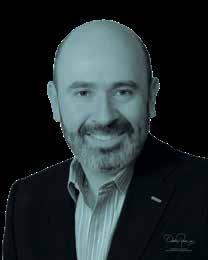
TMedical Tourism,
Mexico is the Second
EXCLUSIVE INTERVIEW WITH SECRETARY OF TOURISM, MIGUEL TORRUCO . TOURISM CAN BE DOMESTIC OR INTERNATIONAL WHEN VISITING ANOTHER COUNTRY. TODAY, THE “SMOKELESS INDUSTRY” IS A MULTIBILLION DOLLAR BUSINESS AND ECONOMICALLY SUSTAINS ENTIRE NATIONS: FRANCE RECEIVES 100 MILLION PEOPLE A YEAR; SPAIN, 85 MILLION; THE UNITED STATES, 67 MILLION; ITALY, 57 MILLION; TURKEY, 55 MILLION; AND OUR COUNTRY, 42 MILLION VISITORS.
here is adventure tourism, rural tourism, ecotourism, cultural tourism, religious tourism, convention tourism, LGBT tourism, shamanic tourism, sports tourism, gastronomic tourism, wine tourism, romance tourism, and health tourism. The latter involves trips whose primary motivation is to improve a person’s health.
In other words, those who travel to other cities, countries, or continents to regain health, undergo treatments, surgeries, or even attend a consultation are considered health tourists. Some people come to America from Asia or Oceania to achieve a sculpted body by undergoing plastic surgery in Cuba or Miami. Many Mexicans go to Houston to enter an operating room. However, in recent years, due to much more affordable prices and the high specialization achieved, the Mexican border has received hundreds of thousands of U.S. residents who visit a doctor.
in preventive medicine and now also in aesthetic medicine.
El Heraldo USA sought out Dr. Martín Fernando Medina, a dentist on the border between Nogales, who told us that 40% of his patients are of Latino origin but live in the United States; 20% are Anglo-Saxons, and 40% are Mexicans residing on this side of the border. In other words, 6 out of 10 mouths he examines belong to residents of the United States.
Medical tourism becomes an excursion or even a comprehensive health trip if they stay overnight in Mexico
Every day, they cross the border on foot or by car to improve their physical, mental, emotional, and even spiritual quality of life. We have great strength in curative medicine, meaning rehabilitation and therapies. We are a power
To give you an idea of the savings for families in the southern United States: a third molar surgery in Nogales, Tucson, or Phoenix, Arizona, costs $900; and having it done in his Mexican office only costs $350, confirms Martín.
The phenomenon of medical tourism on the Sonora border has brought significant investments to open comprehensive clinics, and competition has grown, which further benefits the “gringos” who come for treatments to Heroica Nogales. Dr. Medina himself is surprised by the high-quality equipment being installed, making him think that there might even be opportunities for money laundering investments.
Our interviewee went further and even shared an anecdote: “Once, Gustavo, I received an American resident of Polish origin, and she asked for a porce-
lain crown. When I was ready to anes thetize her to grind the tooth, she asked me not to inject her. She told me that through meditation and breathing chan ges, she could control the pain. And what I did. Without a drop of anesthesia, I did my job, and now she even sends recommended patients.”
As a scientist, he confirmed that selling medicines, mostly antibiotics, a “bargain” for those living there since it’s very easy to get all kinds of drugs here, unlike in drugstores. And of cour se, the “Americans” take advantage the opportunity to have fun with tequila, eat carnitas, barbacoa, quesadillas, or a carne asada. In other words, medical tourism becomes an excursion or even a comprehensive health trip if they stay overnight in a Nogales, Sonora, hotel.
How big is the demand for patients the so-called “Great Nogales Border” both private higher education schools, the Binational University and the CEUNO University, offer dentistry as a major?
El Heraldo USA interviewed Secretary of Tourism Miguel Torruco Marqués, who provided revealing data: Does the Ministry of Tourism have data on how many people cross the der each year for medical treatments?
Miguel Torruco (MT): Estimates from different sources show an annual avera ge of 1.2 million tourists who arrive each year for health reasons.
According to the Study on Market Opportunities and Health Tourism Perspectives in Mexico by Deloitte, around 77% of health tourists are border residents from the southern United States, and based on Google Trends, besides the United States, Canada, the United Kingdom, India, and Malaysia are the countries with the most searches for surgeries in Mexico.
Do you have estimates of the economic impact this represents?
MT: The size of the health tourism in dustry is estimated at between $8 billion and $8.8 billion, of which between $2.7 billion and $3.5 billion correspond to rect contributions from both tourists day-trippers.
Of these, between $4.1 billion and billion come from foreign tourists and


Tourism, a $9 Billion Industry
Second Largest in the World
anesasked that chanthat’s anesthesia, sends me antibiotics, is since drugs courof tequila, or medical even stay hotel. patients in Border” that schools, CESecretary Marqués, have bortreatments? from averaeach inbillion $2.7 to ditourists and $4.5 and
day-trippers.
What is being done to capitalize on this need of Americans?
MT: In coordination with the three levels of government and the private sector, we are working on developing complementary infrastructure to meet the needs of a more informed and demanding tourist. Through the Operation Toca Puertas tours, authorities and businesspeople have the opportunity to promote their main segments, including health.
The Deloitte study refers to the design of a value chain matrix for the industry, identifying the “moments of truth” that the customer faces at each link to better understand the experience of tourists coming for health reasons.
Is it time to invest in the border to build clinics and hospitals?
MT: Mexico is a highly attractive country for Foreign Direct Investment, and particularly in the tourism sector, there have been significant advances in the current administration, where health tourism has a great opportunity area.
From 2019 to the second quarter of 2024, a flow of Tourism Foreign Direct Investment (TFDI) amounting to $13.2073 billion was recorded, which is 122% more than what was captured from 2013 to the second quarter of 2018. In the second quarter of this year alone, the main states that captured TFDI were Quintana Roo, Baja California Sur, and Baja California, destinations highly sought after by health tourists.
Between $4.1 billion and $4.5 billion come from foreign tourists and daytrippers
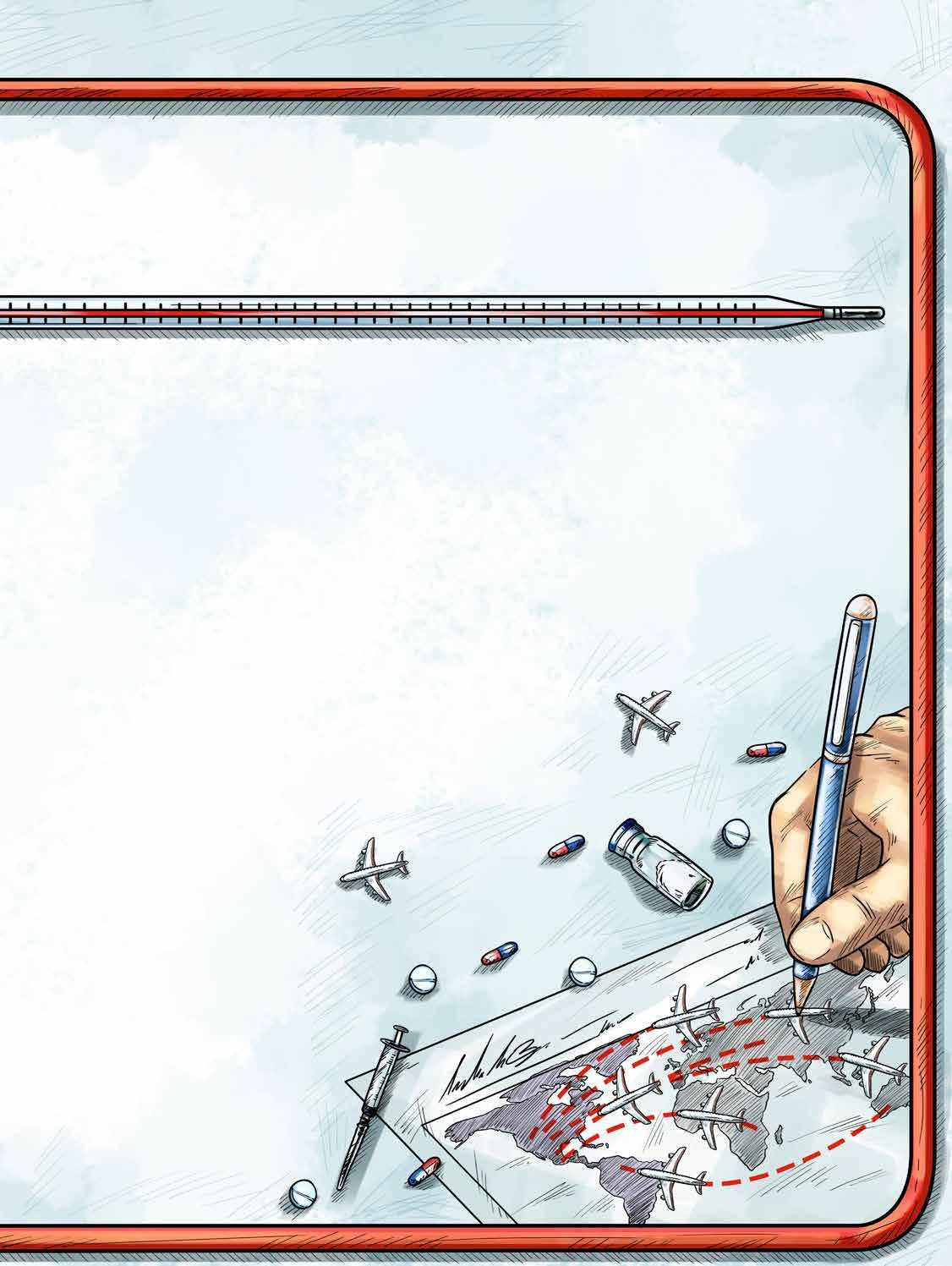
Are there security forces deployed to ensure the safety of our health visitors?
MT: Security is the responsibility of other agencies with whom we have a close relationship. An example is the collaboration between the National Guard and Sectur’s Green Angels, who, through their Geointelligence Center, share information on incidents detected on road sections to strengthen traveler care.
Are medication prices on the Mexican side more affordable? Have you noticed that people also visit us to purchase these products?
MT: It has been noted that the prices of
health treatments in Mexico are indeed a factor that attracts foreign tourists and day-trippers. However, there is no conclusive data to confirm this fact. The closest indication is a study by the Baja California government, where 45% of surveyed tourists stated that the price was a motivating factor driving the demand for health tourism.
Is it true that Mexico is the second-largest health tourism destination in the world?
MT: Based on global estimates, we can affirm that yes, we are the second-largest health tourism destination worldwide.
Do we know what types of treatments are most requested?
MT: Based on information from health institutions and associations, the most requested treatments are general surgeries, plastic surgeries, and dental treatments.
Which state in the country is most visited by health tourists?
MT: Baja California.
Is there enough healthcare personnel for this sector? Do we need more doctors
and nurses at the border?
MT: The staff is sufficient, but given the growth trend, the personnel will increase, and it is important that they are adequately trained to meet the needs of a more demanding and informed tourist. The Secretary of Tourism appointed by the next President of the Republic, Josefina Rodriguez Zamora, has a great task, particularly to take advantage of medical tourism, which, according to estimates, could grow by 35% in the next five years.
As you can see, dear HERALDO USA reader, Mexico is more than beaches, colonial cities, wildlife, museums, archaeology, and conventions; we are also a great attraction in medical offices

Migration is a global reality. More than 300 million people live in a place different from where they were born. Particularly, in the Americas, we have seen constant migration flows.
HThe Power
BY EUNICE RENDÓN
owever, in the last six years, it is estimated that around 10 million people have transited through Mexican territory. Unlike traditional migration patterns, which were mostly Central American, we have seen significant flows from countries like Venezuela, Cuba, and Haiti over the past three years. In 2024, significant contingents from Ecuador, Colombia, and Guatemala have also joined these flows. These enormous migration flows and the large number of caravans that have formed since 2018 have created problems for Mexico's migration system. The constant pressure from the United States on Mexico to retain and receive migrants from various countries transiting through our territory has created new challenges for migration policy. One of the most important ones, is to have a humane, safe, orderly, and coherent policy that aligns with what we demand for our Mexican migrants in the neighboring country to the north.
In Mexico, after the unfortunate incident in Ciudad Juárez where 40 migrants lost their lives and many others were injured in a migrant station, many NGO´s and migrant advocates
raised their voices. In this context, the coalition of organizations Agenda Migrante and more than 350 experts and civil associations developed a Decalogue for Safe, Orderly, and Humane Migration, which they presented to the migration and foreign affairs committees in the Mexican Congress and the National Institute of Migration authorities to demand and promote urgent changes. One of the most important points included in the decalogue was the physical and operational transformation of migrant stations in the country. As part of this process, for almost a year now, the National Institute of Migration (INM) with the support of the Ministry of Foreign Affairs through AMEXCID, has initiated physical and functional changes in the country's most emblematic migrant stations. Agenda Migrante has contributed through the implementation of MigrARTE, a project that seeks to provide a more humane and welcoming experience in these spaces through colorful transformation and joint work with migrants and officials working in these sites. These stations, originally designed two decades ago under a penitentiary scheme, are being transformed. MigrARTE aims to use art, color, and the active participation of migrants through a series of participatory and psycho-emotional workshops to turn gray, sad walls into colorful canvases while

MigrARTE aims to use art, color, and the active participation of migrants through a series of participatory and psychoemotional workshops EUNICE RENDÓN
Agenda Migrante has contributed through
implementation of MigrARTE.
PHOTOART: IVAN BARRERA
Power of Colors
making people feel better during their transit. Colors have a transformative power on human moods, influencing our emotions and generating feelings of calm, hope, and joy. Warm colors like yellow and orange can induce sensations of energy and friendliness, while blue and green tones are known for their calming and relaxing effects. This intervention not only improves the space esthetically but also contributes to the mental and emotional health of migrants, providing a more positive and encouraging environment.
The designs and phrases included in the fourteen modified stations so far have involved the active participation of migrants through interactive workshops, where they chose to display messages and representations that allude to their countries of origin, migratory animals, and elements of nature. The murals reflect diversity by connecting their cultural heritage with the host community and conveying inspiring and supportive messages. In summary, they contribute to leaving a graphic testimony and a trace of their experiences on their journey, their hopes and desires; all symbols of their migrant condition.
Among the testimonials we have collected from people on the move who have passed through these stations, David from Ecuador expressed surprise and satisfaction at finding
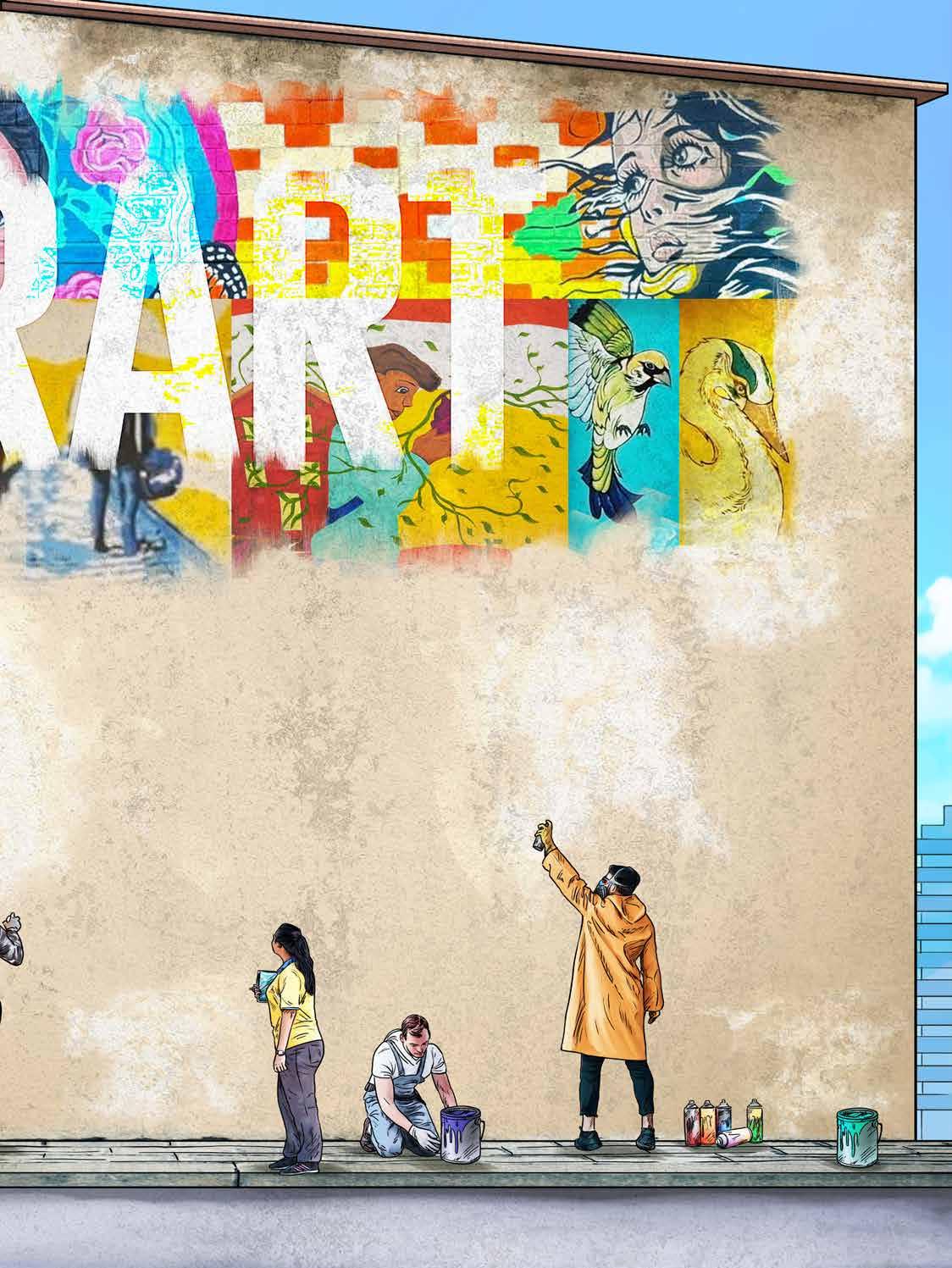
welcoming facilities and spaces. Bruno from Brazil said, "My journey through Mexico has been very difficult. I was extorted and lost everything, and then I was brought here and was very afraid, but I arrived, and the colors made me feel calmer. The food and treatment were very good." Alvin from Guatemala stated, "I was here two years ago, and it was a different thing. Also, I feel more protected because there is a dormitory designated for us from the LGBTQ community."
Mariana from Colombia mentioned, "I thought I was arriving at a prison. I had heard terrible things about these places, and the first thing I see when I enter customs is the phrase 'In every migrant, there is a human story' amidst vibrant colors." Sonia from Guatemala said, "I really like the images of butterflies here. I identify with them because they migrate and fly to other places. They give me hope."
Of course, this colorful transformation is not enough on its own. Therefore, other important changes have also been promoted by the responsible authorities within these areas. People cannot be detained for more than 36 hours. Elements of prison design, such as doors, locks, and bars, have been removed (in the Tapachula station alone, 38 doors were removed).
There have been general improvements to the facilities, including the provision of
More humane attention in a dignified and bar-free space creates a more suitable and compassionate environment
EUNICE RENDÓN
sports equipment, installation of potable water and electricity, plants, medical clinics, and the use of simultaneous translation devices. Additionally, alongside physical changes, a process of reviewing and strengthening protocols related to the operations and attention within the stations has been developed, providing specialized training in human rights, civil protection, first aid, and work with vulnerable populations to the officials working there.
In summary, improving the physical stress environment through art and color complements other profound changes, providing immediate and tangible relief, helping to reduce anxiety for detained migrants. Together, more humane attention in a dignified and bar-free space creates a more suitable and compassionate environment that not only meets legal and human rights standards but also promotes the well-being of migrants.
There is much to be done in migration policies in Mexico, as well as regarding the bilateral relationship and pressures from the United States. However, the beginning of the transformation described here represents a noteworthy advance. These spaces need to be maintained and periodically reviewed to ensure that a tragedy like the one that occurred never happens again.
● These spaces need to be maintained and periodically reviewed to ensure that a tragedy like the one that occurred never happens again.
color,

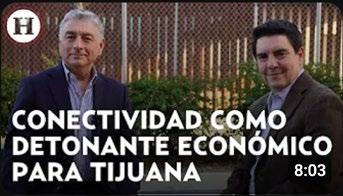
THE CROSS BORDER XPRESS
The Cross Border Xpress, the tunnel that connects the Tijuana airport terminal with California, provides safety and faster crossing into USA by expediting the migration and customs process, which boosts economic activity. Jorge Goytortúa, CEO of CBX, speaks about the impact of this connectivity.

ECONOMIC CHALLENGES IN THE BINATIONAL RELATIONSHIP
As a key area for binational trade but with challenging issues, several factors can help boost the Tijuana-San Diego region, such as energy distribution, workforce, and security.Listen to Kenia Zamarripa, Vice President of International Business Affairs at the San Diego Regional Chamber of Commerce.
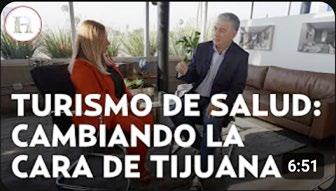
TIJUANA'S HEALTH TOURISM OFFERINGS
Tijuana offers world-class medical services in specialties such as bariatric surgery, plastic surgery, dental care, among others, while also providing alternatives to make the stay more pleasant, such as accommodations with gastronomic experiences. This is the health tourism that Tijuana offers.

FROM TIJUANA TO THE WORLD: JACKIE NAVA, WORLD BOXING CHAMPION
Due to its proximity to the United States, especially Las Vegas, the place where every boxer wants to be, Tijuana is a key point for those who want to enter this sport professionally. It is also the home of Jackie Nava, the first World Boxing Council champion that Mexico saw almost two decades ago.
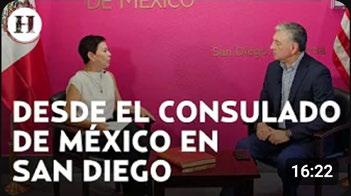

THE ROLE OF THE MEXICAN CONSULATE IN SAN DIEGO LAURA CALDERÓN, DIRECTOR OF JUSTICE IN MEXICO
San Diego is an essential region for understanding the Mexico-U.S. border. Alicia Kerber, head of the Mexican Consulate in that city, explains the consulate's role, which goes beyond serving the migrant community. It also focuses on promoting the community and its development at the border level.
From the University of San Diego in California, Laura Calderón, director of the Justice in Mexico program—a research initiative specializing in public security issues in Mexico, human rights, migration, transparency, and the criminal justice system—talks about a Mexico that can move beyond violence.

ECOLOGICAL FRAGILITY AT THE BORDER
For the environment and resource degradation, there are no borders, and there shouldn't be any in efforts to preserve our heritage. Renowned ecologist Exequiel Ezcurra talks about this from the San Diego Natural History Museum, a space that highlights the ecological fragility of the border region.
Divided by a Wall, Connected The Heraldo USA YouTube you to explore the interaction these
BY: ANGÉLICA SIMÓN UGALDE /
El Heraldo de México visited one the Mexico-United States border, has not been able to contain inertia of economic, cultural, both sides.
Cali-Baja, Tijuana-San Diego, an plore at https://www.youtube.com/@el_heraldousa
Alejandro Cacho and Heraldo Televisión the challenges and benefits of this binational vision to understand and well-being of the area in both countries.
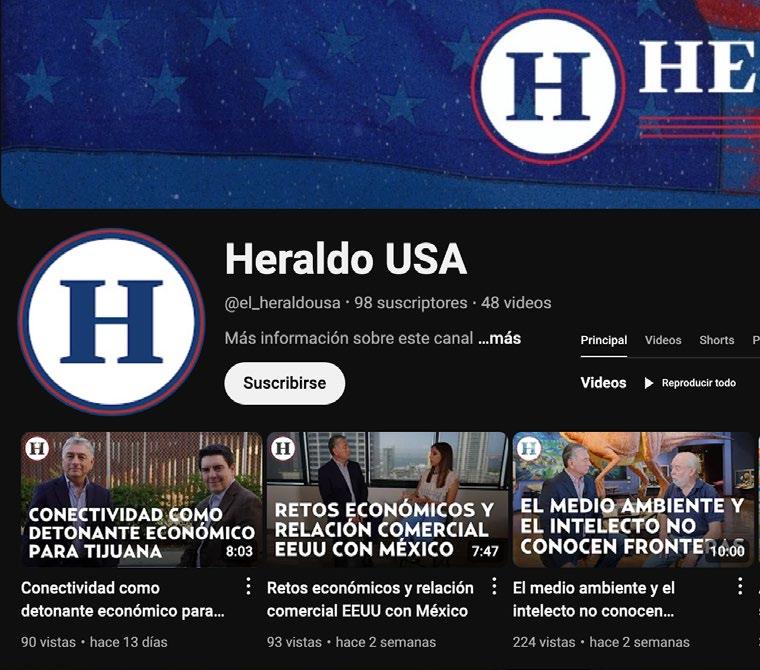
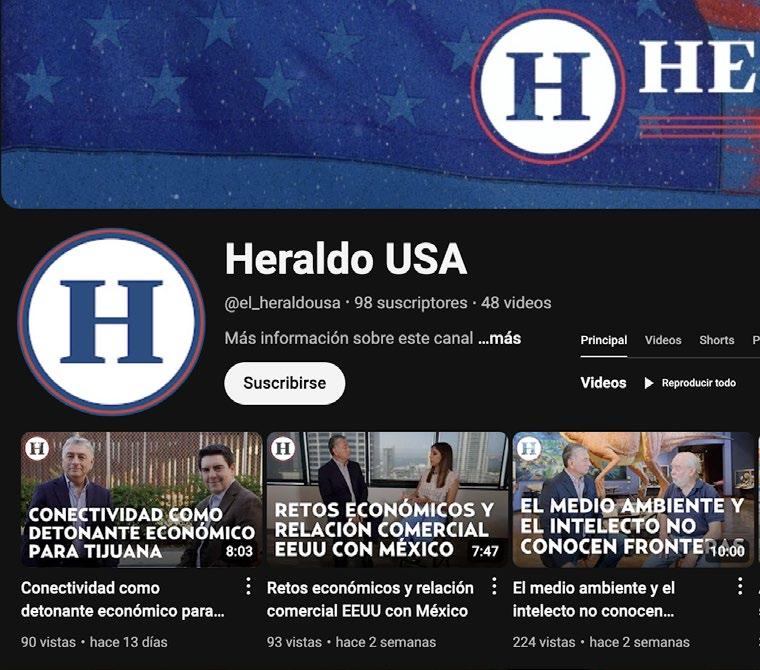

TIJUANA SAN DIEGO,


Connected by Activity.
YouTube Channel takes interaction between
cities
PHOTOART: ARTURO RAMÍREZ
one of the most dynamic regions on border, a geopolitical boundary that the human mobility or the flow and cultural, social, and daily activities between an inseparable duo that you can exhttps://www.youtube.com/@el_heraldousa through journalist Televisión in a series of interviews about neighborhood, and the need for a contribute to the development and countries.
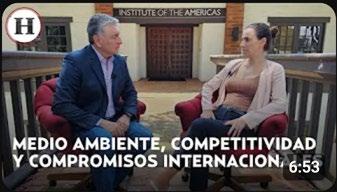
ENVIRONMENT, COMPETITIVENESS, AND INTERNATIONAL COMMITMENTS
The competitiveness of a country no longer depend solely on infrastructure, but on the type of infrastructure. Mexico must advance in its energy transition to provide clean fuels and energy explains Tania Miranda, Director of Environment & Climate Change at the Institute of the Americas.

ANGELS AT THE BORDER
The nonprofit organization Border Angels supports around 10,000 migrants every day providing food and refuge. Luis Osuna, a member of the organization, calls for people's solidarity to continue advocating for human rights, humane immigration reform, and social justice through donations.

TIJUANA: A FERTILE LAND FOR HUMAN MOBILITY, EMBRACING MIGRATION
Roxana Rosas Fregoso, an academic at the UNAM Institute of Legal Research - which operates a legal clinic in Tijuana to ensure the human rights of migrants- discusses the major challenges facing Mexico and the United States in achieving orderly and humane migration with full respect for rights.

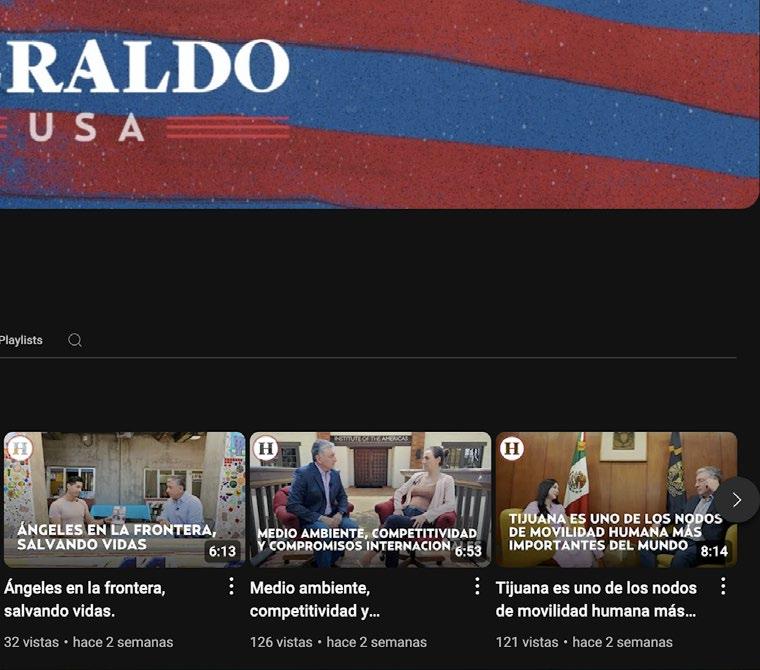

TIJUANA AND DIEGO,

THE INSTITUTE OF THE AMERICAS, A STORY OF COOPERATION
Richard Kiy, President of the Institute of the Americas, discusses the cooperative link between the U.S. and Latin America and highlights that in the regions where San Diego and Tijuana converge, about 7 million people live, and more than 80,000 people cross the border daily to work in San Diego.
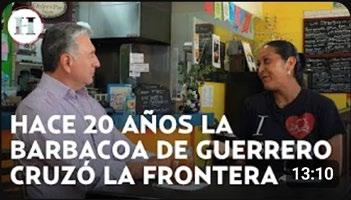
THE FAMOUS BARBACOA FROM GUERRERO IN SAN DIEGO
The authentic flavor of barbacoa made in Mexico is the secret that took "El Borrego" from selling just three tacos on its first day to 300 kilos every weekend. Originally from Acapulco, the founder of this Mexican restaurant in San Diego, Rodnia, shares her story of perseverance and success.


TIJUANA HOSTS THE ONLY LUCHA LIBRE MUSEUM
Located in Tijuana, this unique venue in the world, home to more than 7,000 traditional items from the iconic Mexican sport, began as the childhood dream of its founder, Mauricio Limón. He combined his passion for Lucha Libre with his hobby as a collector to make the Lucha Libre Museum a reality.
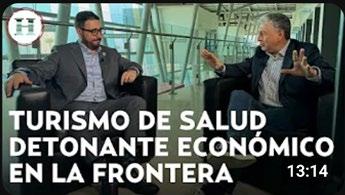
HEALTH AND WELLNESS TOURISM AND BAJA CALIFORNIA'S ECONOMY
In 2022 more than 4.3 million people, most of them from the USA, mainly from California, Arizona, and Nevada, as well as from Canada, visited the state of Baja California to undergo some medical procedure. Miguel Aguíñiga Rodríguez, Secretary of Tourism in Baja California, speaks on the matter.



